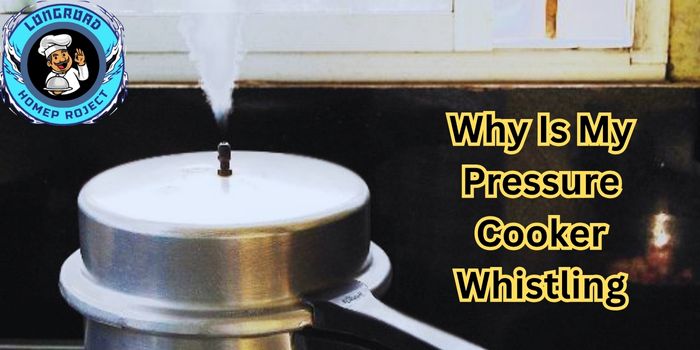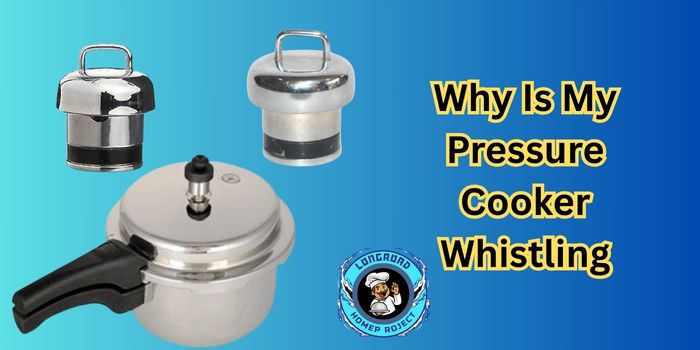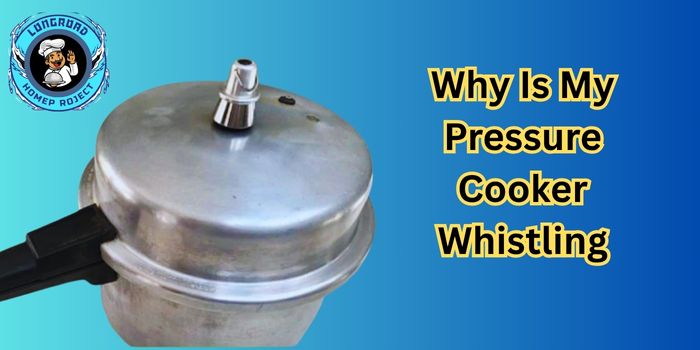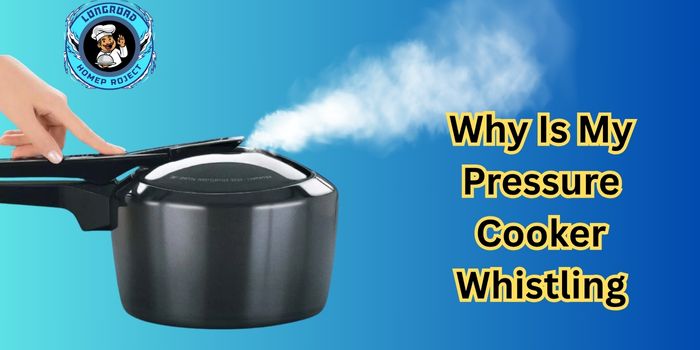As an Amazon Associate I earn from qualifying purchases.
Why is my pressure cooker whistling like a steam engine?” That was the exact thought running through my head the first time I used one. I remember standing in my kitchen, frozen mid-step, completely unsure whether to turn it off, run away, or just pray nothing exploded. The sound was loud, high-pitched, and unexpected—definitely not something I had prepared for.
If you’re here asking, “Why is my pressure cooker whistling?”, you’re not alone. Whether you’re a first-time user or someone who just upgraded to a new model, that sharp, hissing whistle can feel a little intimidating. But here’s the good news: in most cases, it’s a completely normal part of how your pressure cooker works.
In this guide, we’ll break down what that whistling actually means, when it’s normal (and when it’s not), and what to do if things don’t sound quite right. More importantly, we’ll talk about safety—because understanding your pressure cooker isn’t just about cooking faster, it’s about cooking smarter and safer.
You’ll also learn how different types of pressure cookers behave, common reasons for excessive whistling, and how to troubleshoot those nerve-racking sounds—step by step.
Let’s dive in and take the mystery (and anxiety) out of the whistle.
What Causes a Pressure Cooker to Whistle?
Hearing a sudden, loud whistle from your pressure cooker can be startling—but before you panic, it’s important to understand that not all whistling is bad. In fact, some is perfectly normal and even expected, especially if you’re using a traditional stovetop pressure cooker. Let’s break down the main reasons why your cooker might be making noise, and how to tell the difference between a harmless hiss and a potential hazard.
It’s Totally Normal – It’s Releasing Steam
In many traditional stovetop pressure cookers, whistling is a designed safety feature. The whistle or “weight valve” regulates internal pressure by releasing excess steam at intervals. That high-pitched sound you hear? It means your cooker has reached the desired pressure, and now it’s maintaining it by letting out bursts of steam.
Compare that to modern electric pressure cookers, like the Instant Pot, and you’ll notice a huge difference. These usually don’t whistle. Instead, they use digital sensors and internal pressure regulators, releasing steam more quietly—often through a hissing sound or puffing valve. If your electric pressure cooker is whistling, that might actually signal a problem (more on that below).
Bottom line: If you’re using a stovetop cooker, a regular whistle is totally fine. It’s doing its job.
You May Be Using Too Much Heat
One of the most common causes of loud, aggressive whistling is excessive heat. Here’s what happens: high heat rapidly increases internal pressure, which in turn forces more steam out of the valve—causing louder and more frequent whistles.
Personal tip: Start cooking on high heat to build pressure, but once the first whistle blows, immediately reduce to low or medium-low heat. This keeps the pressure stable and prevents overcooking or unnecessary steam loss.
If you leave the burner cranked up, the cooker keeps building pressure beyond what’s needed—and the valve has to keep whistling to compensate. That’s not just noisy, it’s inefficient and could lead to food drying out or sticking to the bottom.
Blocked or Dirty Steam Valve
Sometimes, that intense whistling—or no sound at all—means something’s wrong. A blocked steam valve is a major culprit. Over time, grease, food particles, or residue from starchy dishes like rice or beans can clog the vent pipe or pressure regulator.
What to listen for:
- A higher-pitched or erratic whistle
- A strange, sputtering noise
- Steam leaking from areas it shouldn’t (like the sides of the lid)
If steam isn’t exiting through the intended valve, pressure could build dangerously. That’s why cleaning the valve after every use is crucial. Some lids even allow you to remove and rinse the valve separately—do it!
Overfilled Cooker
We’ve all been tempted to sneak in “just a little more” when cooking a big batch—but overfilling your pressure cooker is a fast track to noisy problems.
Most cookers have a clearly marked “max fill line,” which is there for a reason. If you exceed it, there may not be enough headroom for steam to circulate. That can lead to liquid or food particles being forced into the vent pipe, causing:
- Constant or irregular whistling
- Spitting or foaming from the valve
- Risk of clogged vents (again!)
And don’t forget, some foods expand as they cook—like lentils, pasta, or grains—making the overfill even worse.
Pro tip: For safety, never fill more than 2/3 full for most foods and 1/2 full for foods that foam or expand, like beans or rice.

Why Is My Pressure Cooker Making a High-Pitched Noise?
Common Sounds and What They Mean
Not all noises from your pressure cooker are cause for concern. Some are perfectly normal. But it’s important to know what the different sounds actually mean:
- Whistling: This is the most common noise in stovetop cookers. It’s simply steam escaping through the pressure release valve. Think of it as the cooker’s way of saying, “Everything’s under control.”
- Screeching: This could signal a tight pressure build-up, or that steam is being forced through a partially blocked vent. It’s louder and more intense than the usual whistle.
- Rattling: Often happens when the pressure regulator or safety valve is loose or if the cooker is shaking due to high heat.
Pro Tip: Always note what your pressure cooker usually sounds like. That way, if something sounds “off,” you’ll recognize it right away.
When It’s Normal vs. When to Be Concerned
Let’s break it down:
Normal:
- Gentle whistling once the cooker reaches full pressure.
- A steady hiss of steam escaping in short bursts.
Cause for concern:
- Continuous high-pitched whistling (it shouldn’t go on endlessly).
- Unusual vibrations or loud rattling.
- No sound at all, even when you expect pressure (could mean blocked vent or lack of heat).
If your cooker starts screeching, it’s trying to tell you something is wrong. Take it off the heat and let the pressure come down naturally. Then inspect the vent, gasket, and valve.
What to Do If the Pressure Cooker Whistles Nonstop
Step-by-Step Troubleshooting
If your pressure cooker just won’t stop whistling—even after you’ve lowered the heat—try these steps:
- Turn down the heat: High heat increases internal pressure fast. Lowering the flame lets it stabilize.
- Check the steam valve: Food residue or grease buildup can clog the vent. Let it cool and clean it thoroughly.
- Inspect the sealing ring (gasket): A damaged or misaligned ring can cause irregular pressure release.
- Make sure the cooker isn’t overfilled: Too much food or liquid leaves no space for steam, causing constant whistling.
- Let pressure release naturally: If unsure, remove it from heat and let the pressure drop on its own before opening.
🟩 Important: Never force open a pressure cooker while it’s actively whistling or under pressure.
Real-Life Example – What I Did When Mine Kept Whistling
One evening, I was making lentil soup and got distracted watching a cooking show. I had cranked the stove too high and forgot to lower it after the first whistle. Before I knew it, my kitchen sounded like a teapot on steroids. The whistling wouldn’t stop.
I panicked a bit but remembered to:
- Turn off the heat.
- Let it sit untouched.
- Check the valve once it cooled.
Turns out, a bit of lentil foam had crept up into the vent. A quick cleaning fixed it—and now I never fill beyond the two-thirds mark.
Lesson learned: Watch your heat, don’t overfill, and give your cooker some love with regular cleaning.

How to Prevent Whistling Issues in the Future
If your pressure cooker tends to whistle too often or too loudly, prevention is key. These simple tips can help you avoid unnecessary noise, ensure proper cooking pressure, and extend the life of your appliance.
Clean the Vent and Gasket Regularly
Over time, tiny bits of food or grease can clog the steam vent or weaken the sealing gasket. This blockage increases pressure irregularly, triggering more frequent or louder whistles. Make it a habit to clean both the vent tube and the rubber gasket after every few uses using a soft brush and warm soapy water. Let them dry fully before reassembling.
Don’t Overfill the Cooker
Always check the maximum fill line etched inside your pressure cooker pot. Filling beyond this limit leaves less space for steam, which increases pressure too quickly. This can cause intense whistling or even safety valve activation. As a rule of thumb:
- Fill no more than ⅔ full for most dishes.
- For foods that foam or expand (like beans or grains), fill only halfway.
Follow the Manual for Max Liquid Levels
Each pressure cooker model has specific guidelines for how much liquid is required to build proper pressure safely. Too little liquid can cause the cooker to overheat, while too much liquid may clog the valve. Read the instruction manual for your model, and always use the recommended minimum amount of liquid (usually 1–2 cups).
Use the Right Heat Setting for the Recipe
Using high heat throughout the entire cooking process is a common mistake. Start with high heat to build pressure quickly. Once it reaches pressure (you’ll hear a whistle or see the float valve rise), immediately reduce the heat to medium-low or low. This keeps the pressure stable without excessive whistling. If you keep the heat too high, it forces steam out rapidly, causing loud or nonstop whistling.
Is the Whistling Different for Electric Pressure Cookers?
Yes, there’s a big difference when it comes to the sounds produced by stovetop vs. electric pressure cookers—especially the iconic whistling noise.
Key Differences Between Stovetop and Electric Models
- Electric Pressure Cookers Don’t Usually Whistle
Unlike traditional stovetop models that release steam audibly through a vent (often with loud whistles), electric pressure cookers are designed to regulate pressure silently or with minimal noise. They rarely, if ever, produce a loud whistling sound. - Internal Mechanisms Handle Pressure Automatically
Electric models like the Instant Pot use advanced sensors, safety valves, and internal regulators to control pressure buildup and release. When steam is released, it’s typically a soft hiss, not a sharp whistle. This makes electric models more user-friendly and quieter in general. - What If You Hear Whistling from an Electric Cooker?
While it’s rare, a high-pitched sound or whistle from an electric pressure cooker may signal something’s wrong—like a loose sealing ring, blocked steam release, or improperly seated lid. If this happens, pause the cooking cycle and check the manual.
Quick Tip: If you’re upgrading from a stovetop model to an electric one, don’t be alarmed by the silence—it’s working just fine!

FAQs
Why does my pressure cooker keep whistling?
✅ Your pressure cooker likely keeps whistling due to excess pressure buildup. Lower the heat slightly and check if the steam release valve is working properly. Whistling is a normal part of pressure regulation, but if it continues too long, it may need attention.
What to do if the pressure cooker whistles?
✅ First, reduce the heat to help the cooker stabilize. Then, check the steam vent and sealing ring for any blockages or debris. Make sure the pot is not overfilled, especially with liquid or foamy foods like beans or rice.
Why is my pressure cooker making a high-pitched noise?
✅ A high-pitched noise usually comes from steam escaping rapidly—this could indicate a faulty valve, worn gasket, or even food particles clogging the vent. Inspect the lid and clean all components thoroughly.
Is it safe if the pressure cooker whistles continuously?
✅ Not always. If your pressure cooker whistles nonstop, it could mean the pressure is too high or the valve is blocked. Turn off the heat, allow pressure to release naturally, and check the cooker before using it again.
Conclusion
That loud, high-pitched whistling might seem intimidating—especially if you’re new to pressure cooking—but it’s not always a reason to panic. In fact, whistling is often completely normal and simply signals that your cooker is regulating pressure.
However, it’s just as important to know when it’s not normal. If the sound becomes excessive, continues for too long, or is paired with steam leakage or strange smells, it’s time to investigate. Most of the time, simple maintenance like cleaning the vent, checking the gasket, or adjusting heat can prevent these issues.
👉 Confidence tip: Once you get familiar with the different sounds your cooker makes, you’ll know exactly what’s going on. And soon, that whistle won’t scare you—it’ll reassure you that your meal is cooking safely.
🧽 Keep your cooker clean, follow the user manual, and always pay attention to how it behaves. A little care goes a long way toward a safe, quiet, and flavorful pressure-cooking experience.
As an Amazon Associate I earn from qualifying purchases.
